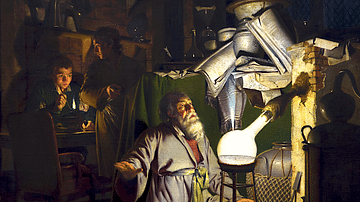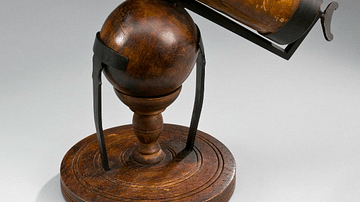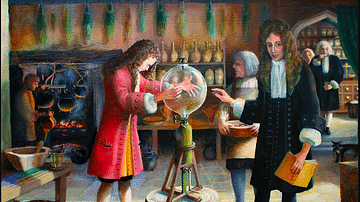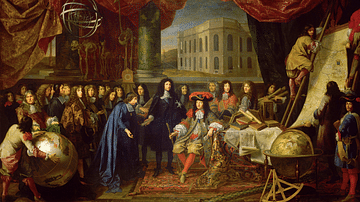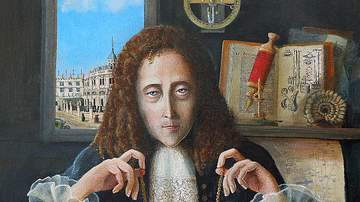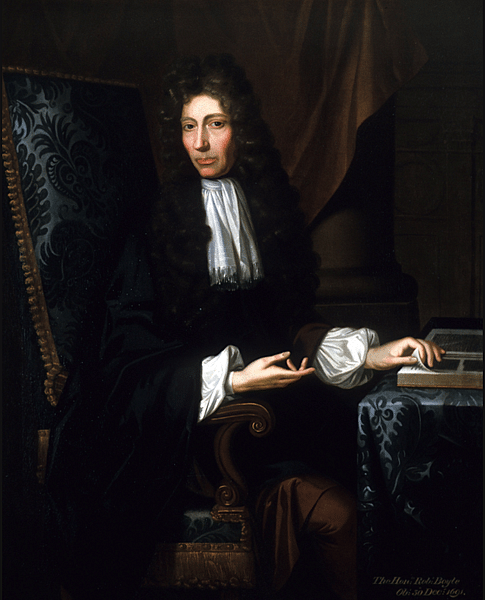
Robert Boyle (1627-1691) was an Anglo-Irish chemist, physicist, and experimental philosopher. Boyle was a prolific author, made significant experiments with air pumps, and presented the first litmus test. A founding member of the Royal Society, Boyle bequeathed funding for a long-lasting series of lectures, the Boyle Lectures, which aimed to show that the Christian faith and science were not incompatible.
Early Life
Robert Boyle was born on 25 January 1627 in Ireland. His father was Richard Boyle (1566-1643), the English landowner who later became the Earl of Cork. Robert was privately educated and then attended Eton College, but unusually for a leading figure of the Scientific Revolution, he did not study at a university. Boyle's education was rounded out by conducting a grand tour of Europe between 1639 and 1642, taking private lessons along the way with a tutor in tow. Robert lived in a manor house in Stalbridge, Dorset, in southern England from 1644, which was paid for by his father. In the mid-1650s, he moved to Oxford. In 1668, Boyle moved again, this time to Pall Mall in London, where he shared a home with his beloved sister Katherine.
Approach to Science
Free to pursue any interest that took his fancy and with plenty of family money to spend on expensive experiments and equipment, Robert was most interested in natural philosophy and conducting practical experiments that would help explain how the world around us works. To that end, Boyle gave employment to Robert Hooke (1635-1703), who acted as his lab assistant in Boyle's purpose-built laboratory, which was filled with bizarre and cutting-edge scientific apparatus and devices. Another of Boyle's young lab assistants who went on to greater things was Francis Hauksbee (1660-1713), who made several discoveries concerning electricity. A third important assistant, really Boyle's director of experiments, was the Frenchman Denis Papin (1647-1713).
Boyle was a prolific writer of books, too, and because he was not short of money, he could afford to publish most of them in Latin, which meant his reputation easily spread to other countries. Boyle's books on mathematics, religion, and medicine were popular, so much so that he became a frequent victim of plagiarism.
In his works, it is clear that Boyle was against any sort of -ism. He did not completely agree with mechanical philosophers who held that everything has a material cause, that is, all natural phenomena must be reduced to motion and matter. Neither did he adhere to Cartesianism, Aristotelianism, or Paracelsianism, which were the most popular methods of understanding the world around us at that time. Boyle, rather than following one all-encompassing method of inquiry, preferred to tackle individual problems using observations and chemical experiments most pertinent to the task at hand. In this sense, Boyle was in agreement with the approach forwarded by Francis Bacon (1561-1626). Above all, for Boyle, practical experiments beat systems of thought.
One system of thought that did appeal to Boyle was Christian theology. A devout Christian, Boyle saw no conflict with the endeavours of science (or what might better be called natural philosophy in those days) and his faith. Boyle wrote on this subject the year before he died in his book The Christian Virtuoso (1690). When not experimenting, Boyle spent a great deal of time and money on evangelism. He paid for translations of the New Testament into languages such as Irish, Lithuanian, Malayan, and Turkish. He wrote extensively on theology and financially supported missionary work.
Experiments with Air Pumps
One area of experimentation that seemed to particularly fascinate Boyle was the use of air pumps. This was still an experimental device itself, but luckily for Boyle, in his assistant Robert Hooke, he had one of the foremost experts in using the device. Boyle's pump, actually built by Hooke, was unique since it included a vessel in which specimens (live or otherwise) could be subjected to variations in air pressure. The instrument is here described by L. Jardine:
The completed pump consisted of a large glass receiver (about thirty quarts in volume) with a four-inch opening at the top through which experimental apparatus could be inserted. A brass cylinder with milled valves, in which a sucker could be made to rise and fall by turning a handle attached to a geared ratchet, was mounted on a wooden frame below the receiver. A stop-cock was inserted at the bottom of the receiver and a valve at the top of the cylinder. (54)
Boyle published the results of his air pump experiments in his 1660 book New Experiments Physico-Mechanical Touching the Spring of the Air, and Its Effects. The book was actually written by his assistant Papin, who was made a fellow of the Royal Society in 1680 for his own work in this field, including inventing the pressure cooker.
Boyle formulated a principle which became known as "Boyle's Law". This law states that the pressure exerted by a certain quantity of air varies inversely in proportion to its volume (provided temperatures are constant). Boyle, in fact, was only the first to demonstrate the law since it had already been proposed by two earlier thinkers: Richard Towneley (1629-1707) and Henry Power (1623-1668). Boyle and his assistants were able to demonstrate how a vacuum could exist, for a time called the "vacuum Boylianum". Not everyone agreed that Boyle had created a vacuum in his glass dome using an air pump or even that such a thing could exist at all; Thomas Hobbes (1588-1679) was the most vocal opponent of Boyle's work with vacuums.
It was Boyle, too, who called the new device used for measuring air pressure the barometer (although the device itself was invented by Evangelista Torricelli, 1608-1647). Boyle's work on air pressure, especially his law and experiments with pressure gauges and pistons, would prove an inspiration to the creators of the steam engine that literally and figuratively powered the Industrial Revolution.
Alchemy & Chemistry
Boyle was a great supporter of the new science of chemistry, and he was keen to restore its reputation, which had suffered for its association with alchemy. Boyle published a sprawling overview and defence of chemistry in his lengthy The Skeptical Chymist, published in 1661. Although highly critical of some alchemists and chemical tricksters, Boyle was not against this ancient field of study, believing that the chemical experiments in search of a way to transform base metals into gold using a catalyst device called the philosopher's stone often had value in themselves as exercises in investigative chemistry. Indeed, Boyle used his political connections to repeal a law in England that prohibited the alchemical manufacture of silver or gold (although nobody had ever found a successful method to achieve either).
Boyle even practised alchemy himself using mercury (he wrote a treatise on these experiments), and he does seem to have been genuinely convinced that the transmutation of metals was possible (in both directions: base to gold and gold to base metals); he even describes how the philosopher's stone, if found, might be used to attract angels and spirits (another age-old belief of alchemists). Boyle was completely against, though, the secrecy of the alchemists who corresponded with each other in code and would not share their chemical findings with anyone else. This was a crucial difference with the new scientific method, which prioritised the clear sharing of information and subjecting that information to critical analysis and comparative testing.
It is surprising that such a mind as Boyle's was so willing to believe in the transmutation of materials, even if he kept his science and alchemy as quite separate activities. So much did Boyle want to believe in alchemy that he became a soft touch for unscrupulous tricksters. One Georges Pierre des Clozets, an alchemist fraud claiming to represent a secret society headed by the Patriarch of Antioch, managed to fleece Boyle of large sums of money for investment in dubious experiments. Boyle also sent extravagant gifts to Georges for the non-existent patriarch, such as a globe, a telescope, a clock, and a lavish binding of the New Testament. None of the gifts managed to gain Boyle entry into the secret society. When the experiments never showed any results, Boyle was fobbed off with wild stories such as the alchemists' castle had been blown up by enemies of their secret society and all the very promising research lost.
As with some other figures of the Scientific Revolution, Boyle's views on alchemy and science proper have unsettled some historians who have struggled to reconcile these seemingly opposite approaches to discovering new knowledge. It is certainly noteworthy that Boyle's executors destroyed much of his library on alchemy so as not to tarnish his reputation as a scientist, a form of whitewashing that the work of Isaac Newton (1642-1727) also underwent after his death.
Boyle did remain a respected scientist in his own lifetime, and he was, accordingly, one of the founding fellows of the Royal Society in London in 1662, an organisation set up to better share and advance knowledge, particularly in the fields of mathematics and physics. Boyle served on the society's council but declined an offer of the presidency in 1680. Boyle made countless contributions to the unofficial magazine of the Royal Society, Philosophical Transactions. The aim of the Royal Society was to increase knowledge of nature, but men like Boyle (and Bacon before him) wanted to subdue nature before the intelligence of scientists, what he described as making nature "serviceable to their particular ends, whether of health, or riches, or sensual delight" (Henry, 107). In other words, Boyle wanted practical benefits for his investment in experiments.
Boyle's Other Innovations
Another Boyle work dealing with chemistry was 1664's Experiments and Considerations Touching Colours, which, amongst its many other points of interest, introduced the reader to a prototype of the litmus test – that is the test to determine if a substance is acidic or alkaline or neutral. Boyle's test observed colour changes when a specific sample was dipped into what he called "syrup of violets" on white paper.
Although mostly a practical scientist, Boyle did formulate a famous theory, that of corpuscles, as here summarised by the historian W. E. Burns:
Boyle's "corpuscularian" matter theory had roots in both atomism and alchemy. It held that tiny particles of matter coalesce to form corpuscles, the basic building blocks of material substances, and it explained the properties of matter by the nature and structure of these corpuscles. (40)
Essentially, for Boyle, anything could be made by rearranging these corpuscles – which stuck together because of their particular shape (not because of their atomic structure, which was still then unknown) – and this is perhaps why he still adhered to the antiquated belief that gold could be made from some other material. Alchemy was merely trying to speed up what nature itself could already do, and gold was, for Boyle, the purest of all corpuscularian substances. Boyle and Newton were close friends, and his ideas on corpuscles do seem to have influenced Newton (another dabbler in alchemy and experiments involving mercury) for his theory of light being made up of different elements, that is, several varied types of coloured light which come together as a whole to make something new: white light.
Putting all of these ideas together, Boyle's combined studies of air pressures, chemistry, and corpuscles led him to once describe the human body as a "hydraulico-pneumatical engine" (Moran, 161). This did not mean God was not involved, for Boyle believed the human body, although a sophisticated mechanism, still needed some divine power and wisdom to set it going, maintain it, and allow it to pursue certain ends. This divine power and wisdom was, for Boyle, the Christian God, and, crucially, God's ultimate purpose for humanity and the universe can never be known.
Death & Legacy
Robert Boyle, after a lifetime of dubious health, died on New Year's Eve 1691 in London. He had never married and had no children. In his will, he left generous provision for a series of lectures to be delivered each year in London. The aim of the Boyle Lectures was to defend Christianity against anyone who was atheist, diminished the divine power of God, or belonged to other religions such as Judaism and Islam. In this period, many Christians were worried about a perceived rise in atheism, a phenomenon that could be made worse by unscrupulous and unfaithful scientists. Christians, and particularly Boyle, wished to do something about this by defending the Christian faith and demonstrating through science the wonders of God's work (as they put it), such as the inexplicable sources of energy like gravity and moving planets seen through a telescope and the intricate anatomical details of insects seen through a microscope. Regarding the Boyle Lectures, there was also a condition that the speakers did not mention the differences between Christians. Held from 1692, the lectures and their subsequent publication in book form were very popular. The lectures ran, although not every single year, through the 18th and 19th centuries before being discontinued in the early 20th century and then revived from 2004.





